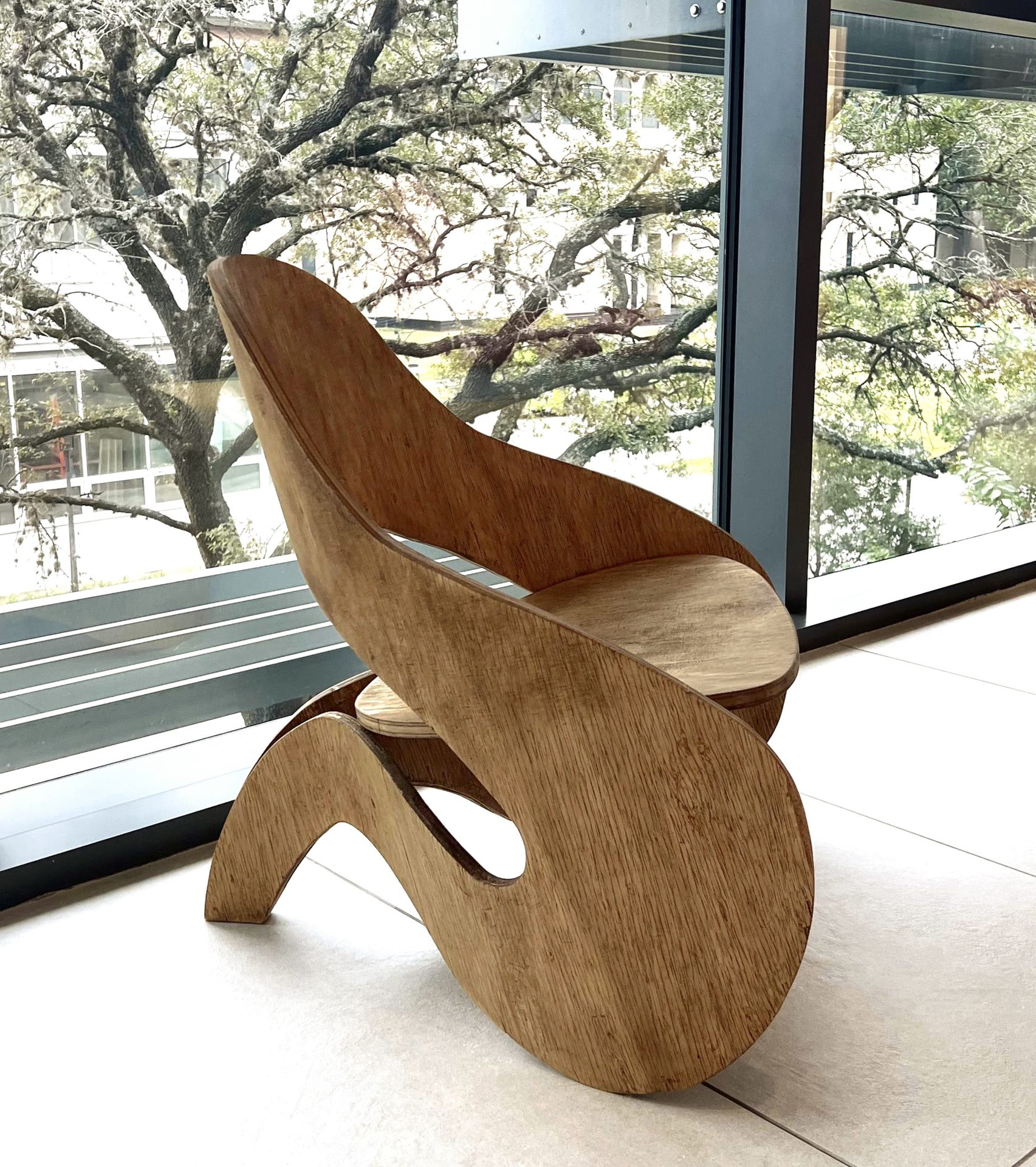The Perfect Fits
Industrial design students win FIT Sport Design Awards with innovative equipment and apparel designs
by Nicholas Nguyen • April 24, 2023
This spring, the 2023 FIT Sport Design Awards honored six industrial design student winners from the University of Houston Gerald D. Hines College of Architecture and Design. The annual competition recognizes exceptional designs across the world that demonstrate solutions for enhanced sports performance and sustainability.
Congratulations to Akanksha Bhatia, Diego Romero, Emily Sonnier, Luis Valdes, Toluwalase Adedipe, and Estelle Lee, who developed their projects in the INDS 4500 studio, led by assistant professor of industrial design Elham Morshedzadeh, Ph.D.
“As their professor, I was impressed by the level of commitment demonstrated by my senior students during this project,” shared Morshedzadeh. “Their task was no small feat — to generate novel and practical concepts addressing significant social and environmental challenges. It was a true test of their educational experience, drawing on both their technical skills and ability to think critically and creatively.”
Akanksha Bhatia ’23
Winner in Sport Equipment Design – Sailing & Surfing
Nautis
A single-person sailboat prioritizing portability and sustainability. The design is focused on sailors who enjoy traveling and has limited space for storage. Nautis breaks down the sailboat to its most fundamental parts and allows for easy set-up and disassembly thanks to its lightweight design.
What inspired this project?
Akanksha Bhatia: I have always enjoyed outdoor activities casually. Every time on vacation when my family passes by a pretty lake, all I can think of is, “I wish I could sail on it.” As we moved closer to a lake this past summer, my family bought a couple inflatable kayaks to take out onto the water. I thought, “Why not a portable sailboat?” and that is where it all started.
What was your design process?
AB: First, I did in-depth research on existing portable sailboats and kayaks. I looked at material, ease of use, longevity, and weight. From there, I started designing following my inspiration of a folded paper airplane. After much testing, I solidified my concept of the main hull and added the sails and other details through other inspirations, such as tent poles. Finding inspiration in things that were not sailboats really helped me work out the kinks in my design.
How do you feel about winning?
AB: This was a fun project for me, and on top of that, it was the first design competition I won. The win gives motivates me to design more for the years to come. Most importantly, it confirmed that hard work and enjoying what you do pays off. After celebrating, it is time to put my head down and continue working hard and working with joy.
Diego Romero ’23
Winner in Sport Equipment Design – Parasports
STRIDE SIGHT
Blackout goggles with haptic and audio feedback for visually-impaired para-athletes competing in track competitions in the T11 category, filling a need for a product that does not currently exist.
What inspired this project?
Diego Romero: My project was inspired by the awe I experienced when I watched videos of visuallyimpaired runners performing at the highest level. Seeing them run as fast and asaccurately as they do — all while blindfolded — immediately reminded me of superheroes. Iwanted these athletes to feel like superheroes.
What was your design process?
DR: After locking down the main premise of my project, I wanted to meet with myusers and get some insight into what they thought about the concept and innovation. During my ideation phase, I met with TEAM CATAPULT, a Houston runningorganization for visually impaired runners, to talk to them about myproject. Their approval and feedback went directly into the final product of STRIDE SIGHT.
How do you feel about winning?
DR: Besides being proud of the project itself, it is cool to see parasports and parasportsdesigns getting the recognition and praise it deserves. Hopefully, that trend continuesto grow in all aspects of design.
Emily Sonnier ’23
Winner in Sport Equipment Design – Urban Sports
TOIS - Modular Bag System
A stylish design addressing the need for an adaptable bag for urban life and daily commute by walking, cycling, and public transit. The bag is suitable for social events, work, and fitness.
What inspired this project?
Emily Sonnier: I was inspired after finding myself constantly changing bags while working last summer. Once, I forgot my wallet changing from my work bag to my handbag, and I knew there was a big potential to improve the experience. I also observed my coworkers carrying many bags at once, mainly work and gym bags. I was also inspired by Copenhagen, my favorite city, where biking is the most used method of transportation.
What was your design process?
ES: My process was included indepth research on what was available on the current market. While there was no shortage of modular bags, they were all for camping or military use — not exactly for the average, stylish working woman. I wanted to create a mid-tier luxury bag system, so I investigated many upcoming trends in the luxury bag industry. The most challenging part of the process was learning how to sew and create a custom pattern.
How do you feel about winning?
ES: I have found in design school when you are surrounded by so many talented creatives, you can get in your head about your personal ability. This victory gave me the confidence boost to know I am ready to land a great job after graduation!
Luis Valdes ’23
Winner in Sport Equipment Design – Racket Sports
Spiral (Tennis Machine)
A tennis ball launcher with a collapsible spiral chute and removable backpack component to transport the device. The backpack can store other tennis equipment, and the device features a lights system to help players practice timing and footwork.
What inspired this project?
Luis Valdes: This project was inspired by looking at a previous tennis serving machine and thinking about how the chute for the balls could be collapsed. I thought it would be an elegant way to introduce a new material into a design mostly made of plastic. Its compactness could make it even more convenient for the target users: beginners and tennis teachers.
What was your design process?
LV: The process began with lots of initial sketches and experimentation with different forms for the chute. It was not until I stumbled upon a collapsible AC pipe that I decided this was the direction I wanted to take.
How do you feel about winning?
LV: I suppose winning means I took an approach beating out others, but it probably helped that I found a niche area of sports equipment. I also had a village of people backing me up, but it also was a lot of hard work.
Toluwalase Adedipe ’23
Honorable Mention in Sports Equipment Design
Brisk
A cycling helmet designed for users with high volume or textured hair, focused on accessibility, with an opening to preserve hairstyles and self-cooling with cooling pads.
What inspired this project?
Toluwalase Adipe: As someone with a lot of hair and whose texture is 4c, I find it very annoying to wear caps and helmets. I always come out of it with my hair just looking abysmal. I wanted to help people who share my struggles to stay safe while accommodating the issues they might face having a lot of hair.
What was your design process?
TA: I started by studying helmets on the market first, and then I began to ideate on how I could have a system that would not compromise safety but also give the allowance needed for the hair. I decided to look towards organic and futuristic architecture to inform the aesthetic look of the helmet. The culmination of the two gave birth to Brisk.
How do you feel about winning?
TA: Winning means a lot to me. Having a group of jurors see my design and decide it was worthy to be on their website was a hugely validating moment for me. It gave me confidence to believe in my senses as a designer and allowed me to follow my passion even more.
Estelle Lee ’23
Honorable Mention in Sports Equipment Design
Ripple
Open-ear wireless earbuds for commuting and exercising outdoors with safety at the forefront. The earbuds feature open ear listening for content consumption while staying connected to surroundings as well as features for emergency contact and location tracking.
What inspired this project?
Estelle Lee: In my personal experience running and exercising outdoors in general, I always had fear while doing those activities and felt on edge. Through research and conversations with other women, I realized they experienced the same thing. I wanted to design to make women and femmes feel safer while doing the activities they loved.
What was your design process?
EL: I was inspired by the daily routine of a woman living in the city, including commuting, exercising outdoors, and exposure to different challenges. I ideated by sketching different forms and testing out different designs on different ear types. The headphones are adjustable through heating, like how eyeglasses are adjusted to fit a wider range of ear shapes. Finally, I developed the app to go alongside the wireless earbuds allowing the user to be a couple of taps away from starting location tracking or contacting emergency contact(s).
How do you feel about winning?
EL: With this project, I experienced a lot of ups and downs throughout the process and was even discouraged at some points. Winning is overcoming those struggles and challenges to create a beautiful and functional design. It is an honor to be recognized for the hard work I put into this project.
More College of Architecture and Design Stories

On her experience with faculty members, Vanessa Ortega says, "Many professors in the College were also working professionals. Their stories and industry experience helped paint a picture of what to expect from the industry."

Learn about how the Students Industrial Design Society of America at the Hines College provides resources for students.






